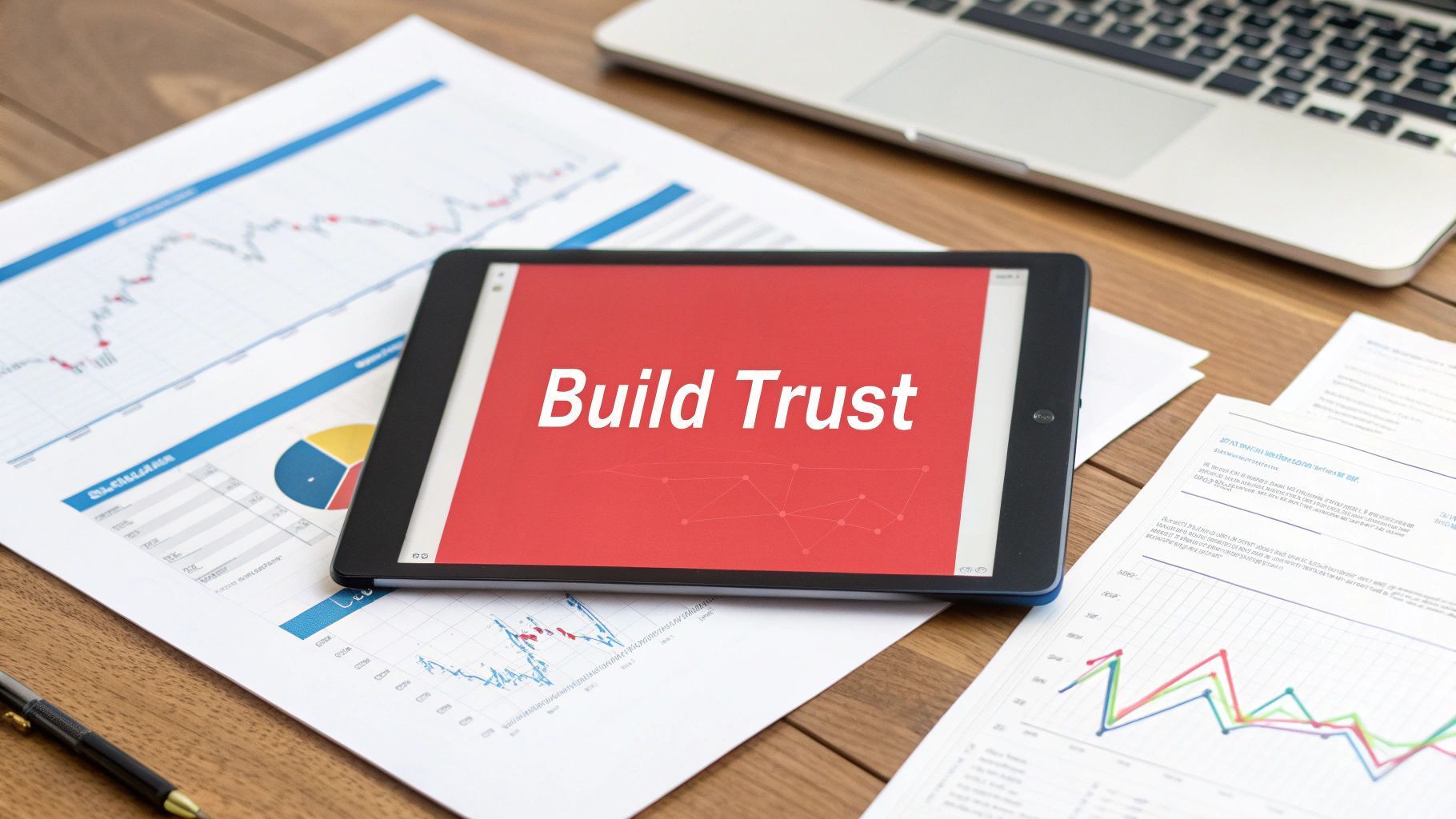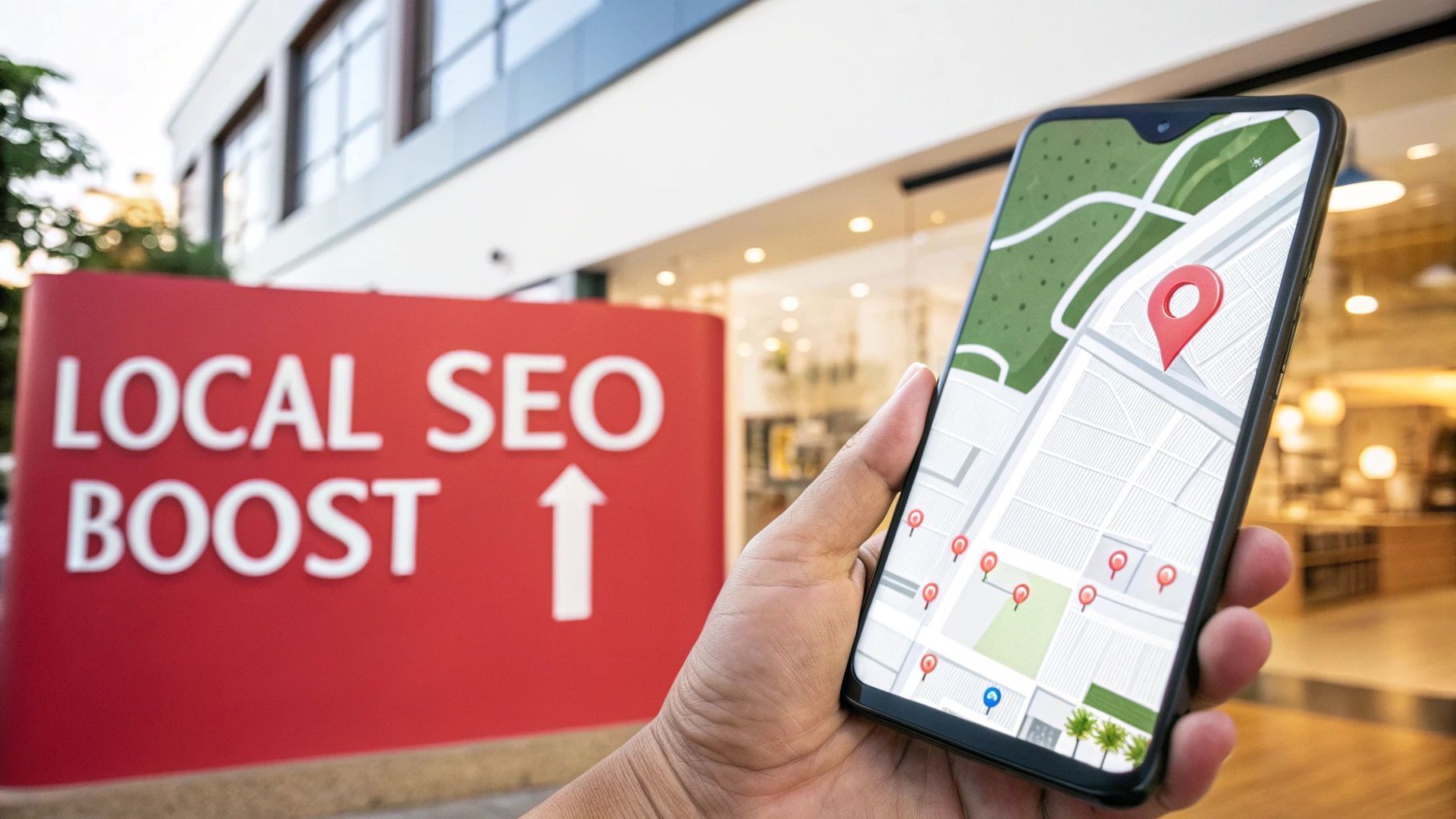10 Customer Retention Strategies That Work in 2025
Acquiring a new customer is an achievement but retaining one is the hallmark of a truly successful business. In a competitive marketplace the battle for market share is won not just by attracting attention but by fostering lasting relationships. Whilst customer acquisition often takes centre stage, the long-term profitability and stability of your brand depend heavily on effective customer retention strategies .
This article moves beyond generic advice to provide a detailed blueprint for implementing robust tactics that deliver measurable results. We will explore ten distinct, actionable methods tailored for forward-thinking businesses, particularly those in dynamic sectors like motorsport, tourism and e-commerce. To truly grasp the essence of long-term business success, it's vital to delve into the strategies for Mastering Customer Retention and Loyalty , which provides a foundational understanding of the principles we will build upon here.
From leveraging AI-driven personalisation to building impenetrable brand communities, the strategies outlined below are designed to turn your satisfied customers into your most powerful asset: loyal advocates. For digital marketing agencies and the ambitious clients they serve, mastering these techniques is not just a value-added service but fundamental to sustainable growth. This guide offers the practical insights you need to build a loyal customer base that champions your brand, drives repeat business and secures your competitive edge. Let's explore the methods that will transform your approach to customer loyalty.
1. Personalised Customer Experience
Personalisation is one of the most powerful customer retention strategies available to modern businesses. It moves beyond generic mass-marketing and instead tailors communications, services and product recommendations to the specific needs, behaviours and history of each individual. This data-driven approach makes customers feel uniquely seen and valued which strengthens their emotional connection to your brand and fosters lasting loyalty.

Pioneered by giants like Amazon and Netflix, personalisation has proven its value. Amazon's recommendation engine is famously responsible for over a third of its sales and Netflix saves an estimated $1 billion annually by suggesting content that keeps subscribers engaged. This strategy is highly effective because it directly addresses customer desires, making their journey frictionless and more relevant.
How to Implement Personalisation
To effectively integrate this strategy, focus on collecting and analysing the right data. Start by creating detailed customer profiles that go beyond basic demographics to include purchase history, browsing behaviour and engagement metrics.
- Segment Your Audience: Begin with broad segmentation based on factors like purchase frequency or location before moving to more granular, behaviour-based groups.
- Use the Right Tools: Leverage Customer Relationship Management (CRM) software and data analytics platforms to automate data collection and identify patterns.
- A/B Test Your Efforts: Continuously test different personalisation tactics such as tailored email subject lines or unique website offers to see what resonates most with your audience.
- Maintain a Human Touch: Whilst automation is crucial for scale, ensure there are opportunities for genuine human interaction, especially in customer service.
By delivering relevant experiences you not only improve customer satisfaction but also increase the perceived value of your offerings. Truly understanding your customer is the first step towards keeping them. You can delve deeper into this topic and discover the power of personalisation in digital marketing.
2. Loyalty and Rewards Programmes
Loyalty and rewards programmes are structured incentives designed to encourage repeat business and foster long-term customer engagement. By offering tangible rewards like points, discounts, or exclusive benefits, these programmes create a powerful reason for customers to choose your brand over competitors. This strategy not only increases transaction frequency but also provides invaluable data on purchasing patterns, helping you to refine your overall marketing efforts.
First popularised in the 1980s by American Airlines, loyalty schemes have become a cornerstone of customer retention strategies for global brands. Starbucks' mobile-first rewards programme now has over 31 million members, driving more than half of its total sales. Similarly, Amazon Prime's subscription model has cultivated a loyal base of over 200 million subscribers who spend, on average, twice as much as non-members. These examples highlight how rewarding repeat custom can directly translate into significant revenue growth.
How to Implement a Loyalty Programme
To create a successful loyalty programme it must be simple, valuable, and seamlessly integrated into the customer journey. The goal is to make customers feel appreciated and give them a clear incentive to return.
- Make It Simple and Accessible: Ensure the programme is easy to understand and join. Customers should be able to track their progress and redeem rewards without friction.
- Offer Attainable and Desirable Rewards: The rewards must be perceived as valuable and realistically achievable. Mix points-based rewards with exclusive experiences to appeal to different customer motivations.
- Communicate Clearly and Consistently: Keep members informed about their point balances, new rewards, and upcoming opportunities. Use expiring points or limited-time offers to create a sense of urgency.
- Consider Tiered or Paid Membership: For your most valuable customers, consider offering a premium tier with enhanced benefits to deepen their loyalty and increase their lifetime value.
Implementing an effective loyalty programme strengthens your brand's relationship with its most valuable customers. You can discover more about using digital platforms to foster this connection by exploring the role of social media in building brand loyalty.
3. Proactive Customer Service and Support
Proactive customer service is one of the most effective customer retention strategies because it shifts support from a reactive to a forward-thinking model. Instead of waiting for customers to report problems you anticipate their needs and resolve potential issues before they even arise. This approach demonstrates a deep commitment to customer success and builds immense trust by showing that you are actively invested in their experience.

This philosophy has been masterfully implemented by companies like Zappos and Amazon. Zappos famously empowers its representatives to do whatever it takes to delight customers resulting in an incredible 75% of purchases coming from repeat buyers. Similarly Amazon’s customer-obsessed culture often leads it to proactively refund or replace items with delivery issues before a customer even has a chance to complain. This level of care transforms a potentially negative situation into a memorable positive one.
How to Implement Proactive Support
To integrate this strategy effectively you must move from merely solving problems to actively preventing them. This requires monitoring customer behaviour and product usage data to identify early warning signs of frustration or failure.
- Empower Your Frontline Team: Give your support staff the autonomy to make decisions without needing multiple levels of approval. The Ritz-Carlton's legendary rule allowing employees to spend up to £1,500 to solve a guest's problem is a prime example of this in action.
- Use Customer Health Scores: Develop metrics to track customer engagement and satisfaction. A dropping score can trigger a proactive check-in from your team to offer assistance.
- Monitor for Untagged Mentions: Actively search social media and forums for conversations about your brand. Addressing issues that aren't directed at you shows you are listening everywhere.
- Automate Proactive Workflows: Create triggered communications for common friction points. For instance send a helpful guide or tutorial video if you notice a user struggling with a specific feature in your software.
By anticipating needs and solving problems before they escalate you prove that your business is a reliable partner not just a vendor. This builds the kind of deep-seated loyalty that is difficult for competitors to disrupt.
4. Customer Education and Onboarding
A structured customer education and onboarding process is one of the most proactive customer retention strategies a business can employ. It systematically guides new users to find value in your product or service as quickly as possible. This approach reduces initial frustration and confusion, ensuring customers achieve their desired outcomes and understand the full potential of your offering. A strong start builds a foundation for a long-term, loyal relationship.
The impact of effective onboarding is significant. Slack, for example, discovered that teams sending over 2,000 messages were overwhelmingly likely to stick around, achieving a 93% retention rate. They then engineered their onboarding to guide users toward this milestone. Similarly, Duolingo's gamified introduction helps users feel a sense of progress immediately, boosting 7-day retention. This strategy works because it closes the gap between purchase and value realisation.
How to Implement Customer Education and Onboarding
To build an effective programme you must first identify the key actions that lead a new user to their 'aha moment' - the point where they truly grasp your product's core value. Your entire onboarding process should be designed to guide them to this point smoothly.
- Map the User Journey: Identify critical milestones and potential friction points from sign-up to activation. Focus on getting users to a quick win.
- Segment Your Onboarding: Create tailored onboarding paths for different user roles or goals. An admin user will have different needs to an end-user.
- Use Multiple Formats: Provide resources in various formats such as interactive tutorials, video guides, and in-depth articles to cater to different learning preferences.
- Celebrate Progress: Use in-app messages or emails to congratulate users on completing key steps or achieving milestones which helps to build momentum.
- Measure and Optimise: Track metrics like completion rates and time-to-value. Analyse where users drop off and refine those steps to improve the experience.
By investing in education you empower customers to become proficient users who integrate your product deeply into their workflows, making them far less likely to churn. It's a fundamental strategy for turning new sign-ups into long-term advocates.
5. Regular Communication and Engagement
Maintaining consistent and valuable communication is a cornerstone of effective customer retention strategies. It involves creating regular touchpoints that keep your brand top-of-mind and transform a simple transactional relationship into a lasting connection. This strategy goes beyond sales pitches, focusing instead on providing ongoing value through content, community and conversation.
This approach has been powerfully demonstrated by brands like Patagonia whose environmental content builds a community far beyond its products and Peloton whose app fosters daily engagement habits leading to a remarkable 92% 12-month retention rate. By regularly delivering relevant and engaging content you build rapport and make your brand an indispensable part of your customer's routine.
How to Implement Regular Communication
Effective engagement is about quality and relevance not just frequency. The goal is to become a welcome presence in your customer's inbox or social feed not a source of noise. Start by building a multi-channel communication plan that delivers value at every stage.
- Segment Your Audience: Group customers based on their interests and past behaviour to deliver personalised content that resonates with them.
- Follow the 80/20 Rule: Ensure 80% of your communication provides genuine value like tips, insights or entertainment and limit promotional content to just 20%.
- Encourage Two-Way Conversation: Use social media polls, email replies and community forums to listen to your audience and make them feel heard.
- Use Behavioural Triggers: Automate timely messages based on customer actions such as a welcome email after a sign-up or a follow-up after a purchase.
By prioritising consistent value over constant selling you create an engaged audience that is more likely to remain loyal. This consistent dialogue solidifies your relationship making customers feel like valued members of a community. You can explore how to build these conversations further by learning about community marketing strategies that work.
6. Customer Feedback and Continuous Improvement
A systematic approach to gathering and acting on customer feedback is one of the most proactive customer retention strategies a business can adopt. It involves creating channels for customers to share their thoughts, analysing that input to find actionable insights and then visibly improving products or services based on what you learn. This strategy demonstrates that you value customer opinions and are committed to meeting their evolving needs, which builds trust and deepens their connection to your brand.
This approach has been a cornerstone for many successful companies. For example, Salesforce’s IdeaExchange platform allows customers to suggest and vote on new features, with the company clearly marking which ideas have been implemented. Similarly, Monzo Bank built its entire product roadmap by actively involving its community in feedback and voting. Closing the feedback loop by showing customers how their input led to tangible changes makes them feel like valued partners in your brand's journey.
How to Implement a Feedback Loop
Effective implementation goes beyond simply asking for opinions; it requires a structured process for collection, analysis and action. The goal is to make providing feedback effortless for the customer and to ensure their voice directly influences your business decisions.
- Offer Multiple Channels: Make giving feedback easy by using various methods like email surveys, in-app pop-ups, social media polls and dedicated feedback portals.
- Respond Promptly: Acknowledge all feedback quickly, even if you cannot implement the suggestion. A simple "thank you, we're looking into this" shows you are listening.
- Communicate Changes: Announce updates and improvements that were driven by customer suggestions. Use blog posts, newsletters or release notes to share how you've acted on their input.
- Prioritise Insights: Create a clear internal process for categorising and analysing feedback. Focus on understanding the underlying problem behind a suggestion and prioritise changes based on your most valuable customer segments.
By creating a culture of continuous improvement fuelled by customer insights you not only enhance your offerings but also build a loyal community that feels invested in your success. You can explore how feedback shapes modern business in this guide to customer-centric strategies.
7. Value-Added Content and Resources
Providing value-added content is one of the most effective customer retention strategies for building trust and authority. This approach involves creating and sharing helpful, educational or entertaining resources that extend beyond your core product or service. By becoming a trusted adviser rather than just a vendor, you create ongoing value that keeps customers engaged and loyal even when they are not actively making a purchase. This strategy nurtures a deeper emotional connection with your brand.
This concept was popularised by content marketing pioneers like Marcus Sheridan with his 'They Ask, You Answer' philosophy. Brands like HubSpot have masterfully used this by offering a vast library of free marketing resources, making them the go-to educational hub for their industry and building a loyal customer base. Similarly, home improvement stores like B&Q offer DIY tutorials and workshops that empower customers, encouraging repeat business and establishing their expertise in the field.
How to Implement Value-Added Content
To successfully execute this strategy you must focus on genuinely solving your customers' problems, not just promoting your own products. Your goal is to become an indispensable resource they turn to for information and guidance within your niche.
- Solve Customer Problems: Research the questions, pain points and topics your target audience is actively searching for. Create content that provides clear, actionable solutions.
- Create Evergreen Resources: Focus on developing content like guides, tutorials and foundational articles that remain relevant and valuable over a long period.
- Diversify Your Formats: Cater to different learning preferences by offering a mix of blog posts, videos, webinars, podcasts and downloadable checklists.
- Offer Exclusive Value: Gate some of your premium content, such as in-depth reports or specialised webinars, exclusively for existing customers to make them feel valued.
- Promote and Refresh: Actively promote your resources across email and social media channels. Regularly update your content to ensure it remains accurate and fresh.
By consistently delivering high-quality, useful information you not only improve customer satisfaction but also build a powerful moat around your business. You can explore more about how to create impactful resources and boost your growth with content marketing for small business.
8. Exclusive VIP Experiences and Recognition
Creating exclusive experiences for your most valuable customers is a powerful customer retention strategy that fosters deep emotional loyalty. This approach moves beyond simple discounts and offers special benefits and recognition that make top clients feel genuinely appreciated and part of an exclusive community. It taps into the psychological principles of belonging, status and reciprocity to build a bond that transactional relationships cannot match.

This tactic is expertly used by luxury brands and innovative companies. Sephora's Rouge members gain access to private shopping events and early product launches and American Express Centurion cardholders receive dedicated concierge services and access to exclusive events. These perks are not just about material value but about providing an elevated status and unique experiences that money cannot easily buy, making customers feel like true insiders.
How to Implement VIP Experiences
To effectively develop a VIP programme you must first identify your most valuable customers and then create experiences that resonate with them personally. The goal is to offer value that feels both exclusive and meaningful.
- Identify Your VIPs: Use metrics like Customer Lifetime Value (CLV), purchase frequency and engagement levels to pinpoint your top-tier customers.
- Create Tiered Levels: Establish clear and achievable criteria for different VIP tiers. This motivates other customers to increase their spending to unlock new levels of recognition.
- Focus on Experiential Value: Prioritise unique experiences over simple discounts. This could include insider access to new products, invitations to special events or one-on-one consultations.
- Personalise the Recognition: Tailor rewards to individual preferences. If a top client is a motorsport enthusiast, an invitation to a track day will be far more impactful than a generic gift.
By making your best customers feel seen and celebrated you not only secure their loyalty but also create powerful brand advocates. This approach turns a standard business relationship into a genuine partnership and is one of the most effective customer retention strategies for long-term growth.
9. Subscription and Membership Models
Transitioning from one-off transactions to a subscription or membership model is one of the most effective customer retention strategies for building long-term relationships. This approach shifts the focus from a single sale to continuous value delivery, creating a predictable recurring revenue stream and aligning your business success directly with your customers' ongoing satisfaction. It fosters loyalty by embedding your product or service into their routine.
Pioneered by digital giants like Netflix and Salesforce, this model has proven its worth across industries. Adobe's move to the Creative Cloud subscription significantly increased its recurring revenue and customer lifetime value. Similarly, Amazon Prime masterfully combines a membership fee with a loyalty programme, making it an indispensable part of millions of households. These models work because they create a high-value, low-friction experience that customers depend on.
How to Implement Subscription and Membership Models
To successfully launch a subscription model you must ensure the value you provide consistently outweighs the recurring cost for the customer. The focus is on nurturing the relationship over time, not just closing an initial sale.
- Offer Tiered Options: Provide different membership levels with varying benefits and price points to cater to a wider range of customer needs and budgets.
- Prioritise Continuous Value: Regularly add new features, exclusive content or members-only perks to keep the offering fresh and demonstrate its evolving worth.
- Simplify the Experience: Make it easy for customers to sign up, manage their account and even pause their subscription. A hassle-free cancellation process builds trust and leaves the door open for their return.
- Monitor Engagement: Use data to track how members are using your service. Low engagement can be an early warning sign of potential churn, giving you a chance to intervene with targeted support or special offers.
By creating a system where customers pay for ongoing access you fundamentally change the business dynamic. Your goal becomes retaining them through exceptional, sustained service which is the cornerstone of powerful customer retention strategies. You can learn more about how this model fosters loyalty by exploring the psychology behind subscription services.
10. Win-Back and Re-engagement Campaigns
Win-back campaigns are targeted customer retention strategies designed to re-activate users who have become inactive or have churned entirely. This approach acknowledges that it is often more cost-effective to persuade a former customer to return than to acquire a completely new one. These campaigns use data to understand why customers left and deploy personalised offers, content or product updates to entice them back into the fold.
Pioneered by email marketing platforms like Mailchimp and sophisticated e-commerce brands, this strategy focuses on rebuilding lost relationships. Spotify's personalised win-back emails, which highlight new music and offer discounted subscriptions, have successfully reactivated millions of users. Similarly, Grammarly sends usage-based re-engagement emails showing what users are missing, demonstrating the value proposition and achieving strong reactivation rates.
How to Implement Win-Back Campaigns
An effective win-back strategy begins with understanding churn behaviour and segmenting your inactive audience. You must identify why customers left to create a compelling reason for them to return.
- Segment Your Inactive Users: Group churned customers by their reason for leaving, such as price sensitivity, lack of usage or switching to a competitor. Tailor your message to address their specific pain points.
- Offer a Meaningful Incentive: Provide a compelling reason to return, like a discount, exclusive content or access to new features. Audible often offers returning members reduced subscription rates to restart their membership.
- Be Transparent About Improvements: If customers left due to product gaps or service issues, communicate what has changed since their departure. Acknowledge their previous experience and show you have listened to feedback.
- Make Reactivation Frictionless: Ensure the process for returning is as simple as possible, ideally with a one-click reactivation link. Remove any barriers that could cause them to abandon the process.
By systematically identifying and reaching out to lapsed customers you can recover valuable revenue and turn a potential loss into a demonstration of your brand's commitment to improvement and customer satisfaction.
Customer Retention Strategies Comparison
| Strategy | Implementation Complexity 🔄 | Resource Requirements ⚡ | Expected Outcomes 📊 | Ideal Use Cases 💡 | Key Advantages ⭐ |
|---|---|---|---|---|---|
| Personalised Customer Experience | High - requires data infrastructure, AI integration | High - data management, technology, training | Increased engagement, conversion, loyalty | Businesses with rich customer data & tech capacity | Competitive differentiation, higher ROI |
| Loyalty and Rewards Programmes | Medium - structured programme creation and upkeep | Medium to High - rewards cost, programme management | Increased repeat purchases, brand loyalty | Retail, e-commerce, subscription services | Tangible incentives, switching costs, referrals |
| Proactive Customer Service | High - sophisticated monitoring and analytics needed | High - staffing, analytics tools | Reduced churn, higher satisfaction, trust | High-touch industries, tech products | Pre-empts issues, builds deep trust |
| Customer Education and Onboarding | Medium to High - content creation and specialised staff | Medium to High - training materials, specialists | Reduced early churn, faster adoption | Complex products, SaaS, onboarding phases | Increases adoption, user proficiency |
| Regular Communication and Engagement | Medium - ongoing content creation and channel management | Medium - marketing teams, content resources | Maintains brand awareness, strengthens relationships | Brands seeking consistent engagement | Low cost, scalable, builds community |
| Customer Feedback and Continuous Improvement | Medium - feedback collection and analysis systems | Medium - survey tools, analysis, response processes | Product improvements, customer trust | Customer-centric businesses | Drives innovation, emotional investment |
| Value-Added Content and Resources | Medium - continuous content creation | Medium - content creators, SEO, marketing | Builds authority, improves retention indirectly | Brands aiming for thought leadership | Enhances brand trust, educates customers |
| Exclusive VIP Experiences | High - event planning, personalised offerings | Medium to High - exclusive perks management | Deep emotional loyalty, advocacy | Premium brands, luxury segments | High impact on lifetime value, aspirational status |
| Subscription and Membership Models | High - systems for billing, access, and retention | High - technology, customer success teams | Predictable revenue, higher lifetime value | Recurring revenue models, SaaS, services | Stable income, strong customer ties |
| Win-Back and Re-engagement Campaigns | Medium - targeted automated campaigns, data analysis | Medium - marketing automation, incentives | Recover lost customers, improved retention | Businesses with churn concerns | Cost-effective reacquisition, churn insights |
Crafting Your Retention Blueprint for Sustainable Growth
Navigating the landscape of modern business demands more than just a relentless pursuit of new customers. True, sustainable growth is built on the foundation of the relationships you nurture with those you have already won. Throughout this article we have explored a diverse arsenal of powerful customer retention strategies, moving far beyond generic advice to provide actionable, sector-specific insights. From the deep personalisation of the customer journey to the structured incentives of a well-designed loyalty programme and the critical importance of proactive support, each strategy represents a vital component in a holistic retention framework.
The journey doesn't end with a single successful campaign or a well-received piece of content. The strategies we've detailed, such as sophisticated win-back campaigns, exclusive VIP experiences and comprehensive customer education, are not isolated tactics to be deployed sporadically. Instead, they are interconnected threads in a much larger tapestry. Your goal is to weave them together into a cohesive blueprint that reflects your brand’s unique value proposition and resonates deeply with your target audience, whether they are motorsport teams seeking sponsorship or established enterprises navigating digital transformation.
Synthesising Strategy into Action
The transition from understanding these concepts to implementing them can feel daunting but it doesn't have to be. The key is to avoid a scattergun approach. Rather than attempting to implement all ten strategies at once, begin with a focused, data-driven methodology.
- Start with an Audit: Begin by analysing your existing customer data. Where are your biggest drop-off points in the customer lifecycle? What does feedback from churned customers tell you? This initial analysis will illuminate your most significant vulnerabilities and, in turn, your greatest opportunities. For instance, if post-purchase engagement is low, focusing on value-added content or a structured onboarding process might be your most impactful starting point.
- Select and Customise: Choose one or two customer retention strategies that directly address the weaknesses identified in your audit. If your business model is transactional, a points-based loyalty programme could be a quick win. If you offer a complex service like digital transformation, a robust customer education and resource hub will prove more valuable. The power lies not in the strategy itself but in its customisation to your specific context.
- Measure, Iterate, and Expand: Once you have launched your initial initiatives, establish clear key performance indicators (KPIs). Track metrics such as customer lifetime value (CLV), churn rate, and repeat purchase rate. Use this data to refine your approach. A successful retention programme is not a static document but a living, evolving system that adapts to changing customer expectations and market dynamics.
The Enduring Value of Loyalty
Ultimately, mastering these customer retention strategies is about shifting your organisational mindset from a purely transactional focus to a relational one. It's about recognising that every interaction is an opportunity to reinforce value and build trust. By investing in the customer experience you create more than just repeat buyers; you cultivate brand advocates who become a powerful, organic marketing force for your business. This creates a virtuous cycle of acquisition and retention, solidifying your market position and building a competitive advantage that is exceptionally difficult for others to replicate. To effectively craft your comprehensive retention blueprint, reviewing established customer retention best practices is essential for sustainable growth.
The path to exceptional customer loyalty is a marathon, not a sprint. It requires commitment, empathy, and a persistent focus on delivering undeniable value. By thoughtfully selecting and integrating the strategies discussed here you can build a robust retention engine that not only prevents churn but also fuels long-term, profitable growth.
Ready to put these strategies into action and build unbreakable customer loyalty? Superhub provides the all-in-one platform you need to manage customer relationships, automate communications, and deliver personalised experiences at scale. Discover how our powerful tools can help you build your retention blueprint by visiting Superhub today.





